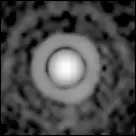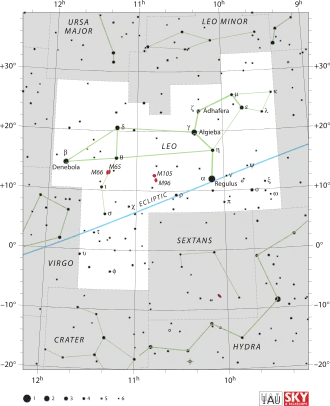R Leonis
R Leonis (kurz R Leo) ist ein veränderlicher Stern vom Typ Mira im Westteil des Sternbildes Löwe. Bereits 1782 wurde seine Besonderheit vom Astronomen Julius August Koch in Danzig entdeckt.[9]
| Stern R Leonis | |||||||||||||||||
|---|---|---|---|---|---|---|---|---|---|---|---|---|---|---|---|---|---|
 | |||||||||||||||||
 | |||||||||||||||||
| AladinLite | |||||||||||||||||
| Beobachtungsdaten Äquinoktium: J2000.0, Epoche: J2000.0 | |||||||||||||||||
| Sternbild | Löwe | ||||||||||||||||
| Rektaszension | 09h 47m 33,48s [1] | ||||||||||||||||
| Deklination | +11° 25′ 43,8″ [1] | ||||||||||||||||
| Helligkeiten | |||||||||||||||||
| Scheinbare Helligkeit | 10,35 mag [2] | ||||||||||||||||
| Spektrum und Indices | |||||||||||||||||
| Veränderlicher Sterntyp | M[3] | ||||||||||||||||
| B−V-Farbindex | +1,30 [4] | ||||||||||||||||
| U−B-Farbindex | −0,20 [4] | ||||||||||||||||
| R−I-Index | +3,24 [4] | ||||||||||||||||
| Spektralklasse | M6e-M9.5e [2] | ||||||||||||||||
| Astrometrie | |||||||||||||||||
| Radialgeschwindigkeit | (14,1 ± 0,6) km/s [5] | ||||||||||||||||
| Parallaxe | (14,06 ± 0,84) mas [1] | ||||||||||||||||
| Entfernung | (232 ± 15) Lj (71 ± 4) pc | ||||||||||||||||
| Visuelle Absolute Helligkeit Mvis | +6,09 mag [Anm 1] | ||||||||||||||||
| Eigenbewegung [6] | |||||||||||||||||
| Rek.-Anteil: | (−5,48 ± 2,32) mas/a | ||||||||||||||||
| Dekl.-Anteil: | (−40,77 ± 1,01) mas/a | ||||||||||||||||
| Physikalische Eigenschaften | |||||||||||||||||
| Masse | (0.7) M☉ [7] | ||||||||||||||||
| Radius | (300) R☉ [8] | ||||||||||||||||
| Leuchtkraft | |||||||||||||||||
| Effektive Temperatur | (2900) K [8] | ||||||||||||||||
| Andere Bezeichnungen und Katalogeinträge | |||||||||||||||||
| |||||||||||||||||
| Anmerkung | |||||||||||||||||
| |||||||||||||||||
Die scheinbare Helligkeit von R Leonis schwankt zwischen +4,4 und +11,3 mag mit einer Periode von 310 Tagen.[3] Im Helligkeitsmaximum ist R Leonis mit bloßem Auge gut zu sehen, im Minimum ist zu seiner Beobachtung ein Teleskop mit mindestens 7 Zentimeter Objektivöffnung nötig.
R Leonis gehört der Spektralklasse M8IIIe an und ist etwa 230 Lichtjahre von der Sonne entfernt.
Einzelnachweise
- R Leo. In: SIMBAD. Centre de Données astronomiques de Strasbourg, abgerufen am 9. September 2018.
- Hipparcos-Katalog (ESA 1997)
- R Leo. In: VSX. AAVSO, abgerufen am 9. September 2018.
- Bright Star Catalogue
- Pulkovo radial velocities for 35493 HIP stars
- Hipparcos, the New Reduction (van Leeuwen, 2007)
- Wiesemeyer et al.: Precessing planetary magnetospheres in SiO stars?. First detection of quasi-periodic polarization fluctuations in R Leonis and V Camelopardalis. In: Astronomy & Astrophysics. 498, Nr. 3, 2009, S. 801–810. arxiv:0809.0359. bibcode:2009A&A...498..801W. doi:10.1051/0004-6361/200811242.
- E. De Beck, L. Decin, A. De Koter, K. Justtanont, T. Verhoelst, F. Kemper, K. M. Menten: Probing the mass-loss history of AGB and red supergiant stars from CO rotational line profiles. II. CO line survey of evolved stars: Derivation of mass-loss rate formulae. In: Astronomy and Astrophysics. 523, 2010, S. A18. arxiv:1008.1083. bibcode:2010A&A...523A..18D. doi:10.1051/0004-6361/200913771.
- Cuno Hoffmeister, Gerold Richter, Wolfgang Wenzel Veränderliche Sterne, 2.Auflage, J.A. Barth, Leipzig, 1984 S. 12
This article is issued from Wikipedia. The text is licensed under Creative Commons - Attribution - Sharealike. The authors of the article are listed here. Additional terms may apply for the media files, click on images to show image meta data.